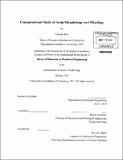Computational study of actin morphology and rheology
Author(s)
Kim, Taeyoon, Ph.D. Massachusetts Institute of Technology
DownloadFull printable version (16.80Mb)
Other Contributors
Massachusetts Institute of Technology. Dept. of Mechanical Engineering.
Advisor
Roger, D. Kamm.
Terms of use
Metadata
Show full item recordAbstract
The cytoskeletal network consisting mainly of actin and actin binding proteins is highly dynamic, provides structural integrity to cells, and plays a central role in a wide range of mechanical and biological functions such as migration and the sensation of external forces. Thus, knowledge of actin cytoskeleton is indispensable for understanding the mechanics and many biological processes of cells. Although various theoretical, computational, and experimental investigations have been conducted, the underlying bases for these critical mechanical properties are still poorly understood. This thesis examines the morphology and rheology of actin networks through the development of a 3-D computational model. First, the viscoelastic properties of actin networks irreversibly bound by actin crosslinking proteins (ACPs) were investigated. Relative contributions of the concentration and type of ACPs, the stiffnesses of actin filaments and ACPs, and thermal fluctuations were evaluated at various prestrain levels. These studies demonstrated for the first time that under typical biological conditions, extensional stiffnesses of both actin filaments and ACPs were surprisingly significant, but thermal fluctuations were relatively unimportant. At high tensions, only a small portion of networks supported a majority of the load. Second, the relative importance of two mechanisms of ACPs which control dynamic properties of actin networks, unbinding and subdomain unfolding, was evaluated. By analyzing the strain-stiffening, stress relaxation, and plastic deformation of the networks with unbinding and/or unfolding, it was found that despite the possibility of unfolding, ACP unbinding is the dominant mechanism governing actin rheology under typical experimental and physiological conditions. In addition, detailed processes by which unbinding plays such a role were investigated. Lastly, roles that molecular motors play in the morphology and rheology of actin networks were studied. Motors enhanced elasticity of actin networks and led to heterogeneous networks to a degree that was highly dependent on how easily the motors unbind from actin filaments. ACPs helped the motors to make networks elastic and prevented the networks from being heterogeneous. Also, morphology of actin-motor networks was significantly affected by boundary conditions.
Description
Thesis (Ph. D.)--Massachusetts Institute of Technology, Dept. of Mechanical Engineering, 2011. Cataloged from PDF version of thesis. Includes bibliographical references (p. 108-114).
Date issued
2011Department
Massachusetts Institute of Technology. Department of Mechanical EngineeringPublisher
Massachusetts Institute of Technology
Keywords
Mechanical Engineering.